Little Village on the Plains

In 1915 or so, if you lived in Hicksville and you wanted to visit your friend Hattie in Mineola, or your cousins in Manhasset, you could walk down to Depot Square (the triangle formed where Jerusalem Avenue met Broadway) and wait by the tracks - for a trolley! Since 1909, following the route shown above, a trolley line had been taking people back and forth. This is the story of that line, the New York and North Shore, of how it came to be, and of how it came to an end.
collection of Mark Thomas, HHS Class of 1975; used with permission
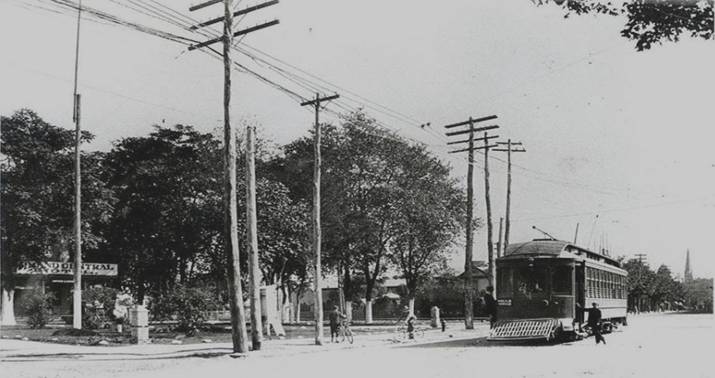
(above)The spire of St. Ignatius church rises in the distance. The Grand Central Hotel of 1835 stands on the left; between the painted tree trunks in the center of the photo, one can make out the edge of the railroad tracks adjacent to the crossing at Broadway. The sign on the trolley car reads simply Mineola Hicksville.
Description of the Trolley Service
The Hicksville terminus of the NY&NS system was not impressive: a single track on unpaved Broadway, extending between John Street and the south side of Depot Square. The track and wire simply ended - or, from the viewpoint of the people of Hicksville, they began - at the LIRR crossing.

Route through Downtown Hicksville adapted from Belcher-Hyde 1914 Atlas of Nassau County
The headquarters of the NY&NS were in Rosyln, from which the line's original tracks extended south, north and west. The branch to Hicksville was newer. When it first opened, it did not connect with the rest of the system; Hicksville trolleys could go only as far west as Mineola. They departed from Depot Square hourly on the half-hour, from 6:30 AM to 9:30 PM. In the warmer months, service was half-hourly.
In July of 1909, the Hicksville branch was connected to the main trackage; alternate departures ran to Port Washington, traveling the 16.5 miles in 80 minutes. Hicksville residents later could enjoy through service to Flushing.
The line's trolleys were new, built to endure the demands of traveling the countryside between towns; people thought them handsome. Exteriors were a greyed green, with the company's initials lettered in gold. Car numbers and fine stripes were a cream color; the wood of the window sashes was covered with clear varnish. Interiors were pale green. The trolleys had plenty of windows, with a clerestory overhead. Seats were upholstered with woven rattan, and a boiler provided hot water heating in cold weather.

Interior of NY&NS Trolley from Seyfried, NY & NS Traction Company
For safety's sake, window openings had guards, as can be seen above. Guards were necessities - even with them, one passenger managed to thrust her arm out an open window, and promptly had it broken by a trolley passing in the other direction. After this incident, the window guards were extended higher than before.
A standard trolley gong ("Clang! Clang! Clang! went the trolley...") warned too-close traffic and pedestrians; a distinctive whistle announced the trolley's approach as it neared rural crossings. Hung at the front end of the cars was a basket-like contraption (known as an Eclipse Fender, visible in the photo below). If it struck anything or anyone, it would lower itself, scooping up the "prey" and preventing its being run over as the trolley stopped.

collection of Mark Thomas, HHS Class of 1975; used with permission
This photo speaks to the company's professionalism: there are two overhead power wires, side by side, although a trolley only needed one. Why two? Using one overhead wire for trolleys running in both directions caused excessive wire wear, leading to more frequent power disruptions. Having two wires, one eastbound and one westbound, cost more money - but service was more reliable.
In general, 5¢ took riders to Mineola or Rosyln, a supplemental fare got them to the edge of Queens, and another took them to Flushing. To better understand the routes of the NY&NS, and to see along which roads they were built, see the detailed map in this article's Appendix.
Creating the New York and North Shore
Despite what local people may have thought, this was not " Hicksville's Trolley." It was a transit line for western Long Island. Revenue came primarily from towns to the west and from Queens, although Hicksville played a role. Why was it built?
Trolley Mania
Around 1900, a craze for trolleys began. Everywhere, small-town businessmen, developers, and politicians thought a trolley line was the catalyst needed to "put their town on the map." Supposedly, trolleys meant jobs and prosperity; they increased property values and spurred growth. Trolley towns collected more taxes - giving politicians more money to spend in order to make voters happy. Besides, trolley lines gave townspeople something to brag about.

Postcard Fake of Trolley Line from Rowsome, Trolley Car Treasury
This postcard of a town is actually a composite of several photographs, made with paste and scissors, darkroom technique, and some hand-drawn details - rails, but no overhead wires! The town never had trolleys, but people who received the postcard didn't know that.
In reality, many trolley lines failed. A critical mass of fare-paying riders was needed to keep such enterprises going.
Entrepreneurs, Investors
New York City's swelling population pushed commuters towards rural Long Island, catching the eyes of two men - a veritable Goliath, and an aspiring one. Global financier August Belmont Jr. had built the IRT, New York's first subway. His many other enterprises included Belmont Park and a fashionable Manhattan hotel. Beneath the latter was a private underground IRT siding, used only by his personal subway car. When the IRT tunnels were extended under the river to Brooklyn, they reached the LIRR tracks, so that Belmont's private car could take him directly between his hotel and his racetrack.
As trolley companies sprang up on Long Island, he sought control of the best of them.
August Belmont, Jr. - George A. Stanley
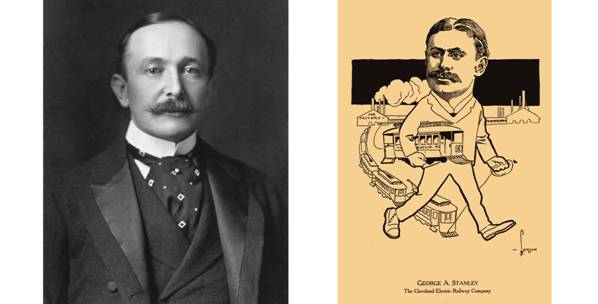
Library of Congress photo - Clevelanders "As We See 'Em"
George A. Stanley was from Cleveland, where he had helped his family build a trolley empire. Looking east, the Stanleys had beaten Belmont to the ownership of two profitable lines in southern Nassau. When Belmont could not put the lines out of business, he bought them from the Stanleys, who profited from the sales.
The Stanley family now contemplated northern Nassau, where trolley lines had been proposed, but never built. Working with lawyer James A. MacElhinny of Rosyln, they revised one of the old proposals, submitted the result, and were granted a franchise. They incorporated the NY&NS, with George Stanley as its President.
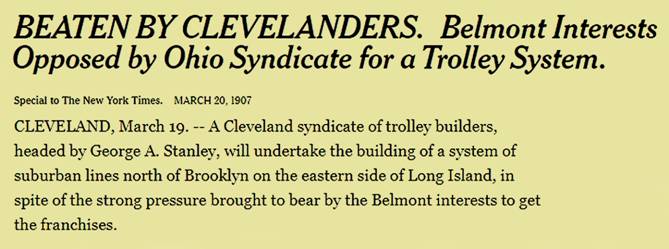
The Stanleys projected modest but solid revenue, revenue which would grow when trolleys reached Hicksville and triggered a population boom. Ridership would grow with the population, and the eastern branch would make a good profit. Nothing was certain, but most likely, the worst expectation was one of déjà vu: the line would be successful enough until August Belmont Jr. bought it.
Opposition, Obstacles
The LIRR did not want new competitors that carried passengers between towns it already served; furthermore, it enjoyed good relationships with Belmont's companies. It would do all it could to prevent the eastward growth of the NY&NS.
At Mineola, the railroad's tracks to Oyster Bay turned north, continuing on to the Sound. Any trolley line heading east would need to bridge them at some point (among other reasons for using a bridge, trolley wires strung across a railroad would not leave enough clearance for trains to pass underneath). If the LIRR learned where the bridge was to be built, the railroad could buy parcels of land the NY&NS needed for the approaches, effectively blocking construction.
Thus, as the NY&NS built the new Hicksville branch, it slowly (and quietly) acquired the real estate needed for the bridge. As the new branch's wire and tracks stretched towards Mineola from the east, they were stopped a good distance from the railroad, so as not to make obvious the location at which the trolley line wanted to construct the bridge.
Although there was no connection to the western part of the NY&NS, eventually there was a usable trolley system east of Mineola; all it needed was some trolley cars. The LIRR guessed correctly that the line would hire movers, to bring some of its trolleys from the west for use on the isolated new branch. The movers would have to transport them along one of the public roads that crossed the railroad's tracks near Mineola. Illegally, the railroad hired "watchmen" (in effect, thugs) to prevent any trolley's being brought east. Nevertheless, one January morning, a trolley stood on the new trolley line. A day later, a second one had joined it. The watchmen, obviously bribed, denied knowing how the trolleys got there.
Thus, on Saturday, January 23, 1909, Hicksville finally got its trolleys. With no trolley bridge to the west, its residents could ride only as far as Mineola. To go further, they had to walk across the railroad tracks, and board the other part of the NY&NS.
Celebration

collection of Mark Thomas, HHS Class of 1975; used with permission
Long Island rail historian Vincent F. Seyfried believed that this winter's day scene shows NY&NS No. 8, festooned with bunting for the occasion, after it made the first trolley arrival at Hicksville.
The NY&NS had worked hard to introduce the new trolley service before the end of 1908. As late December neared, further legal challenges against it were filed by the LIRR, postponing the planned opening of the line. Even so, on New Year's Eve trolley company employees held a long-planned "trolley ball" for townspeople at the Grand Central Hotel.
Anticipation grew in the following weeks, and when the day arrived, a crowd gathered early at the terminus. At 1:30 PM, as the trolley approached, the echoing boom of the town's cannon signaled the arrival. A marching band led a parade of officials and happy townsfolk to "the old country road" - and then right back to the Grand Central for a two-hour ceremony, during which children were given free trolley rides to Westbury and back.

On January 29, 1909, the Huntington Long Islander reporter partook of a little trolley mania, describing the new trolley line with some hyperbole. Noting the railroad's last-ditch legal attempt to block it, he wrote as if the railroad had never deigned to carry passengers between Hicksville and New York City. He also proclaimed that Hicksville had gone from "isolation" to "importance," and that the "little village on the plains" would soon double its population because of the new service.
Of course, the Hicksville-beat reporter may have been deliberately teasing the people in the newspaper's head office - Huntington's own trolley link with Amityville would not be completed for some months.
Success and Decline
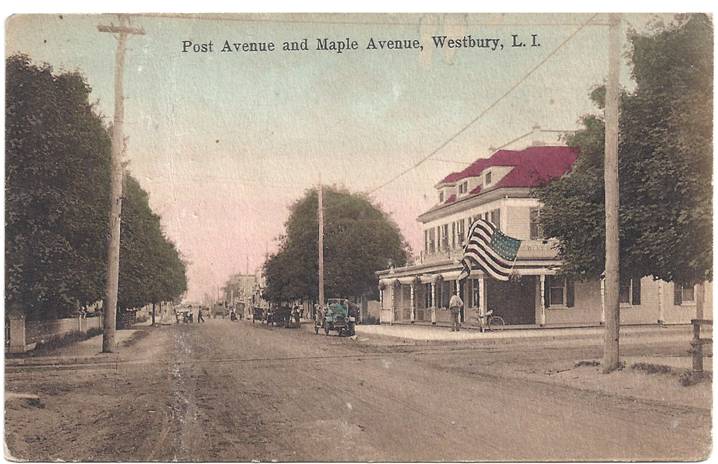
collection of Mark Thomas, HHS Class of 1975; used with permission
As expected, towns took pride in the trolley line. This nicely tinted postcard features Westbury's States Hotel. The photographer framed the shot so as to show the tracks crossing Post Avenue. A similar contemporary postcard shows a trolley on the same tracks. The flag helps narrow the date - the 46-star American flag was in use only until 1912.
A breezy summer ride with open windows felt good to workers returning from a hot day on the job, or to mothers caring for their tots. An autumn weekend trolley foray with one's club was a pleasant way to try something new. People quite enjoyed the new trolley line. Very few complaints were registered, the main one being about rowdy young locals who rode the late night trolley for a while, mocking and insulting fellow passengers.
There soon were rumors that the line was so successful that it would be extended, at first only to Farmingdale, and after that... well, who could tell?
Revenue, Expense
Such was the perception in Hicksville. In Roslyn, the outlook was less bright. After about four years, George Stanley concluded that the line might never become profitable. There were happy patrons, but contrary to his (and his investors') expectations, property values along the new branch had not risen dramatically. The village population was steadily inching upward, but it would not double for some time.

1910 view of NY&NS trestle at Mineola from Seyfried, NY & NS Traction Company
The start-up delays had deprived the NY&NS of months of revenue. The steel Mineola trestle and bridge were built not only upon their foundations, but also upon the dollars that had been spent on legal fees and "secret" real estate acquisitions. To make matters worse, the line's ongoing operating expenses were greater than planned.
Flooding was a cause for concern. The unpaved public roads which the NY&NS followed had never been graded for drainage. In the horse-and-buggy era, when roads near the bays on the North Shore, and near Cushing's Pond (a hollow just north of Mineola ), flooded, people found detours. Trolleys could improvise no detours; the tracks and wire were only where they were. Every year, floods isolated parts of the line for days at a time, shutting off service and revenue.
The price of coal - needed for the NY&NS generating station in Roslyn - was a growing and serious problem. In the first ten years of operation, the wholesale price of coal quadrupled. In 1920-1921, it spiked to ten times the 1908 price. The increased cost of generating electricity could easily force the company into insolvency.
Fare and Unfare
For a while, it appeared that the line might become sustainable if ridership increased soon enough, but to guarantee success, the NY&NS would need a fare increase.
The 5¢ fare - set according to 1908's economic forecasts, which did not anticipate war-related inflation - was regulated by the State's Public Service Commission. For reasons noted above, as the 1910s wore on, fares barely covered operating expenses. Employees were overdue for a raise; when it happened, fares would no longer offset costs. The need for an increase was dire.
Approval for an increase seemed a remote possibility - until NYC Mayor John Francis Hylan joined the fray, and it became completely impossible.

worthpoint.com photo - Library of Congress photo
John Hylan was born to poverty. As a teen, he left the Catskills for Brooklyn (then the second largest city in the country, after New York). He worked on the elevated railway tracks, and slowly advanced to a position as train engineer. In his off-hours, he studied diligently, eventually getting a law degree.
As a trial lawyer, he became acquainted with many judges, which led to his joining the Democratic Party soon after Brooklyn amalgamated with New York City. For years, the efforts of Manhattan-based Tammany Hall failed to establish a good relationship with Brooklyn's Democrats. In 1917, when Hylan's judicial connections proposed him as a mayoral candidate, the idea was accepted as a way to help unite the Democrats of Brooklyn and Tammany. With the Democrats' opposition votes split among three parties, he was elected Mayor.
His peers later recalled Hylan as possessing an unimaginative, child-like mind, and a simple agenda: punishing private transit "interests," especially by constraining them to 5¢ fares. His connections to Albany induced the Public Service Commission to follow his lead.
Disasters, Donations, Demise
Over the final years of service (1917-1921), the NY&NS repeatedly verged on bankruptcy, and there were numerous stoppages of service. The line struggled to survive. Snow and ice became worse problems than floods.
Most of the trolley line ran on public roads, and before automobiles became common, roads were not plowed. Horses could not push plows through snow; instead, they were hitched to sleighs and traveled atop it. Coincidentally, the 1910s sent more big winter storms across Long Island than usual. The photo of the snowbound LIRR train (below, left) was taken in Mineola in April 1915; there was a parade of many other trains stranded behind this one.

(left) Joseph Burt photograph - (right) Snow Sweeper from Seyfried, NY & NS Traction Company
If the railroad could not defeat the storms, how could the NY&NS? It had begun with only one weapon to wield against snow, a rather genteel sweeper (above, right). Realizing that sweepers could not remove the heavy snows that often occur near Atlantic shores, the company purchased a used "push" plow from an upstate railroad. It cannibalized one of its trolleys, and used the parts to devise a powered plow that would operate on the trolley line. The makeshift plow remained on the company's roster until the end of the NY&NS.
Even with its plow, the NY&NS had to shut down during big storms, losing revenue. And again and again, it had to pay laborers to shovel miles of the same tracks into operating shape.
Despite the line's problems and disruptions, the public generally remained loyal. For example, Henry Kuhl, a farmer at Hicksville's boundary with New Cassel, donated land along John Street for the erection of a shelter at the local trolley stop. The trolley line was already under duress, but it was willing to install electrical lighting in the shelter for the benefit of its riders.
The riders wanted to keep the trolleys going. At one point, knowing the line was in trouble, and had been denied a 7¢ fare, some riders started an early precursor to Go Fund Me. When they paid their fares, they voluntarily added two pennies to it. Paying 7¢ soon spread throughout the line. Because the practice had reached Queens, Mayor Hylan was able to bring charges against the NY&NS, which by State law was forbidden to collect more than the approved fare. The company then had to refuse riders' donations.
Eventually, Public Service Commission, still reluctant to raise the basic fare, did permit a restructuring of the fare zones. The result was that long-distance riders now paid more zoned 5¢ fares than they had before, and revenues increased slightly. In this way, the NY&NS was able to obtain more credit and survive a little longer.
The Stanleys tried to sell the line to Belmont's IRT. Acquiring it might have made some sense once the IRT reached Flushing, from which some of its riders might want trolley connections, but that day was years in the future. Although the price was fair, Mayor Hylan also declined the chance to purchase the line for NYC.
Instead, Hylan made a clumsy effort to force the NY&NS out of business. He issued statements about the Stanleys' supposed greed and mismanagement, and he announced that the City was starting to provide bus service over approximately the same routes in Queens. With that announcement, the trolley line's credit was cut off, as it appeared to have no future. Much to everyone's surprise, the Public Service Commission came to the rescue. At that time, NYC had no legal authority to operate a bus franchise, its vehicles and drivers did not meet State standards, and the bus line carried no insurance. New York State shut down the buses, and once again the trolley line could get the credit it needed to operate.
It limped along for a while. Once, it shut down because it could not afford coal for its power plant. Weathering the endless crises steadily grew harder, and finally, impossible. On May 1, 1921, the NY&NS announced that the following day would be the trolleys' last day of service - and it was.
Death, Burial, and Exhumation
What became of the ruins of the New York and North Shore?
The trolley line defunct, Mayor Hylan sent a delegate to approach the line's creditors. Much to their, well... credit, they refused to sell their interests to the regime that had done so much to force the NY&NS into bankruptcy. Unhappy with their refusal, Hylan tried to seize the entire system - but because critical portions of the route ran on private property, it could not be seized without judicial approval. The judge was unsympathetic, and refused to let the City condemn private real estate merely for the Mayor's convenience. John F. Hylan had to give up.
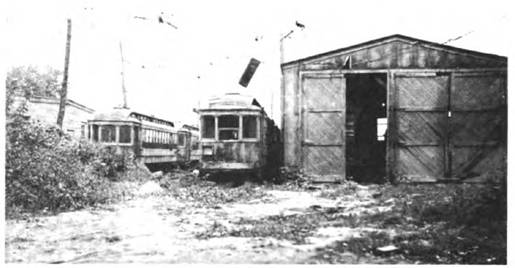
Abandoned Trolleys in Flushing from Seyfried, NY & NS Traction Company
Some of the line's trolleys found new life when they were sold to a Stanley-owned system in Virginia. The rest, and all the remaining assets of the NY&NS, were ultimately sold for scrap - in theory, anyway. In many places, the track was just abandoned in place, so as to avoid the expense and ill will that would have been incurred by digging up streets, removing the track, and restoring the streets afterwards.
As time went by, the towns and counties paved the roads, usually covering the old trolley tracks, which afterwards had a way of poking through here and there. Early in World War II, however, an acute need for scrap metal led the Federal government to unearth more than one million pounds of abandoned steel trolley rail in various Nassau County towns. The old NY&NS yielded its share.
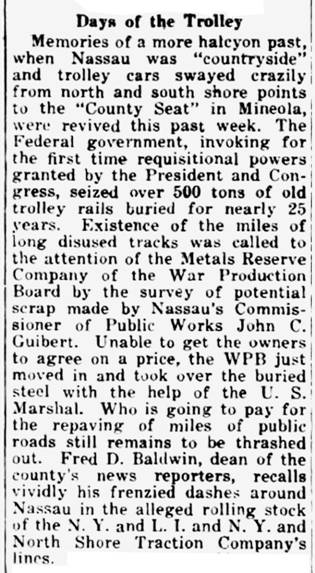
Long Island News-Owl, 6 November 1942
***
August Belmont Junior... George A. Stanley... John F. Hylan...
Manhattan... Brooklyn... Queens... Albany... Cleveland...
It never really was "Hicksville's trolley" at all, was it?
Acknowledgements
I thank my fellow HHS graduate, Mark Thomas (Class of 1975), for sharing with me a number of fascinating items from his postcard collection, only some of which could be included above. They have clarified my understanding of how the NY&NS once fit into Hicksville and Westbury.
The other photographs, and my awareness of the subject, have come from many sources. Among them, the late Vincent F. Seyfried's New York and North Shore Traction Company of course stands out, as do several of his other books. They stitch everything together for me. His incredibly diligent research, preserved in his many books, remains invaluable to those who are interested in the history of Long Island.
Appendix
Complete Track Map of the New York and North Shore

Track Map from Seyfried, NY & NS Traction Company
Drawn by Jeffrey Winslow, who also created the map diagram included at the start of this article

